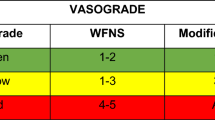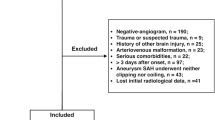Abstract
Purpose
Despite its high prevalence among patients with aneurysmal subarachnoid hemorrhage (aSAH) and high risk of delayed cerebral ischemia (DCI), the Fisher grade 3 category remains a poorly studied subgroup. The aim of this cohort study has been to investigate the prognostic value of the Hijdra sum scoring system for the functional outcome in patients with Fisher grade 3 aSAH, in order to improve the risk stratification within this Fisher category.
Methods
Initial CT scans of 72 prospectively enrolled patients with Fisher grade 3 aSAH were analyzed, and cisternal, ventricular, and total amount of blood were graded according to the Hijdra scale. Additionally, space-occupying subarachnoid blood clots were assessed. Outcome was evaluated after 6 months.
Results
Within the subgroup of Fisher grade 3, aSAH patients with an unfavorable outcome showed a significantly larger cisternal Hijdra sum score (HSS: 21.1 ± 5.2) than patients with a favorable outcome (HSS: 17.6 ± 5.9; p = 0.009). However, both the amount of ventricular blood (p = 0.165) and space-occupying blood clots (p = 0.206) appeared to have no prognostic relevance. After adjusting for the patient’s age, gender, tobacco use, clinical status at admission, and presence of intracerebral hemorrhage, the cisternal and total HSS remained the only independent parameters included in multivariate logistic regression models to predict functional outcome (p < 0.01).
Conclusion
The cisternal Hijdra score is fairly easy to perform and the present study indicates that it has an additional predictive value for the functional outcome within the Fisher 3 category. We suggest that the Hijdra scale is a practically useful prognostic instrument for the risk evaluation after aSAH and should be applied more often in the clinical setting.





Similar content being viewed by others
References
Kramer AH, Hehir M, Nathan B, Gress D, Dumont AS, Kassell NF, Bleck TP. A comparison of 3 radiographic scales for the prediction of delayed ischemia and prognosis following subarachnoid hemorrhage. J Neurosurg. 2008;109:199–207.
Claassen J, Bernardini GL, Kreiter K, Bates J, Du YE, Copeland D, Connolly ES, Mayer SA. Effect of cisternal and ventricular blood on risk of delayed cerebral ischemia after subarachnoid hemorrhage: the Fisher scale revisited. Stroke. 2001;32:2012–20.
van Norden AGW, van Dijk GW, van Huizen MD, Algra A, Rinkel GJE. Interobserver agreement and predictive value for outcome of two rating scales for the amount of extravasated blood after aneurysmal subarachnoid haemorrhage. J Neurol. 2006;253:1217–20.
Hijdra A, Brouwers PJ, Vermeulen M, van Gijn J. Grading the amount of blood on computed tomograms after subarachnoid hemorrhage. Stroke. 1990;21:1156–61.
Jiménez-Roldán L, Alén JF, Gómez PA, Lobato RD, Ramos A, Munarriz PM, Lagares A. Volumetric analysis of subarachnoid hemorrhage: assessment of the reliability of two computerized methods and their comparison with other radiographic scales. J Neurosurg. 2013;118:84–93.
Dupont SA, Wijdicks EFM, Manno EM, Lanzino G, Rabinstein AA. Prediction of angiographic vasospasm after aneurysmal subarachnoid hemorrhage: value of the Hijdra sum scoring system. Neurocrit Care. 2009;11:172–6.
Friedman JA, Goerss SJ, Meyer FB, Piepgras DG, Pichelmann MA, McIver JI, Toussaint LG, McClelland RL, Nichols DA, Atkinson JLD, Wijdicks EFM. Volumetric quantification of Fisher Grade 3 aneurysmal subarachnoid hemorrhage: a novel approach to predict symptomatic vasospasm on admission computerized tomography scans. J Neurosurg. 2002;97:401–7.
Hijdra A, van Gijn J, Nagelkerke NJ, Vermeulen M, Crevel H. Prediction of delayed cerebral ischemia, rebleeding, and outcome after aneurysmal subarachnoid hemorrhage. Stroke. 1988;19:1250–6.
Frontera JA, Claassen J, Schmidt JM, Wartenberg KE, Temes R, Connolly ES Jr., MacDonald RL, Mayer SA. Prediction of symptomatic vasospasm after subarachnoid hemorrhage: the modified fisher scale. Neurosurgery. 2006;59:21–7.
Wilson DA, Nakaji P, Abla AA, Uschold TD, Fusco DJ, Oppenlander ME, Albuquerque FC, McDougall CG, Zabramski JM, Spetzler RF. A simple and quantitative method to predict symptomatic vasospasm after subarachnoid hemorrhage based on computed tomography: beyond the Fisher scale. Neurosurgery. 2012;71:869–75.
Rosen DS, Amidei C, Tolentino J, Reilly C, Macdonald RL. Subarachnoid clot volume correlates with age, neurological grade, and blood pressure. Neurosurgery. 2007;60:259–267.
Rosen DS, Macdonald RL, Huo D, Goldenberg FD, Novakovic RL, Frank JI, Rosengart AJ. Intraventricular hemorrhage from ruptured aneurysm: clinical characteristics, complications, and outcomes in a large, prospective, multicenter study population. J Neurosurg. 2007;107:261–5.
Ko SB, Choi HA, Carpenter AM, Helbok R, Schmidt JM, Badjatia N, Claassen J, Connolly ES, Mayer SA, Lee K. Quantitative analysis of hemorrhage volume for predicting delayed cerebral Ischemia after Subarachnoid hemorrhage. Stroke. 2011;42:669–74.
Gurusinghe NT, Richardson AE. The value of computerized tomography in aneurysmal subarachnoid hemorrhage. J Neurosurg. 1984;60:763–70.
De Rooij NK, Greving JP, Rinkel GJE, Frijns CJM. Early prediction of delayed cerebral ischemia after subarachnoid hemorrhage: development and validation of a practical risk chart. Stroke. 2013;44:1288–94.
Lovelock CE, Rinkel GJE, Rothwell PM. Time trends in outcome of subarachnoid hemorrhage. Neurology. 2010;74:1494–501.
Nieuwkamp DJ, Setz LE, Algra A, Linn FHH, de Rooij NK, Rinkel GJE. Changes in case fatality of aneurysmal subarachnoid haemorrhage over time, according to age, sex, and region: a meta-analysis. Lancet Neurol. 2009;8:635–42.
Fisher CM, Kistler JP, Davis JM. Relation of cerebral vasospasm to subarachnoid hemorrhage visualized by computerized tomographic scanning. Neurosurgery. 1980;6:1–9.
Smith ML, Abrahams JM, Chandela S, Smith MJ, Hurst RW, Le Roux PD. Subarachnoid hemorrhage on computed tomography scanning and the development of cerebral vasospasm: the Fisher grade revisited. Surg Neurol. 2005;63:229–234.
Drenckhahn C, Brabetz C, Major S, Wiesenthal D, Woitzik J, Dreier JP, COSBID Study Group. Criteria for the diagnosis of noninfectious and infectious complications after aneurysmal subarachnoid hemorrhage in DISCHARGE-1. Acta Neurochir Suppl. 2013;115:153–9.
van Swieten JC, Koudstaal PJ, Visser MC, Schouten HJ, van Gijn J. Interobserver agreement for the assessment of handicap in stroke patients. Stroke. 1988;19:604–7.
Rosengart AJ, Schultheiss KE, Tolentino J, Macdonald RL. Prognostic factors for outcome in patients with aneurysmal subarachnoid hemorrhage. Stroke. 2007;38:2315–21.
Woertgen C, Ullrich OW, Rothoerl RD, Brawanski A. Comparison of the Claassen and Fisher CT classification scale to predict ischemia after aneurysmatic SAH? Zentralbl Neurochir. 2003;64:104–8.
Mayfrank L, Hütter BO, Kohorst Y, Kreitschmann-Andermahr I, Rohde V, Thron A, Gilsbach JM. Influence of intraventricular hemorrhage on outcome after rupture of intracranial aneurysm. Neurosurg Rev. 2001;24:185–91.
Brouwers PJ, Dippel DW, Vermeulen M, Lindsay KW, Hasan D, van Gijn J. Amount of blood on computed tomography as an independent predictor after aneurysm rupture. Stroke. 1993;24:809–14.
Czorlich P, Ricklefs F, Reitz M, Vettorazzi E, Abboud T, Regelsberger J, Westphal M, Schmidt NO. Impact of intraventricular hemorrhage measured by Graeb and LeRoux score on case fatality risk and chronic hydrocephalus in aneurysmal subarachnoid hemorrhage. Acta Neurochir (Wien). 2015;157:409–15.
Kramer AH, Mikolaenko I, Deis N, Dumont AS, Kassell N, Bleck TP, Nathan BA. Intraventricular hemorrhage volume predicts poor outcomes but not delayed ischemic neurological deficits among patients with ruptured cerebral aneurysms. Neurosurgery. 2010;67:1044–53.
Roos YB, Hasan D, Vermeulen M. Outcome in patients with large intraventricular haemorrhages: a volumetric study. J Neurol Neurosurg Psychiatr. 1995;58:622–4.
Niikawa S, Kitajima H, Ohe N, Miwa Y, Ohkuma A. Significance of acute cerebral swelling in patients with sylvian hematoma due to ruptured middle cerebral artery aneurysm, and its management. Neurol Med Chir Tokyo. 1998;38:844–50.
Güresir E, Beck J, Vatter H, Setzer M, Gerlach R, Seifert V, Raabe A. Subarachnoid hemorrhage and intracerebral hematoma: incidence, prognostic factors, and outcome. Neurosurgery. 2008;63:1088–94.
Hauerberg J, Eskesen V, Rosenørn J. The prognostic significance of intracerebral haematoma as shown on CT scanning after aneurysmal subarachnoid haemorrhage. Br J Neurosurg. 1994;8:333–9.
Bruder M, Schuss P, Berkefeld J, Wagner M, Vatter H, Seifert V, Güresir E. Subarachnoid hemorrhage and intracerebral hematoma caused by aneurysms of the anterior circulation: influence of hematoma localization on outcome. Neurosurg Rev. 2014;37:653–9.
Haug T, Sorteberg A, Sorteberg W, Lindegaard K‑F, Lundar T, Finset A. Cognitive outcome after aneurysmal subarachnoid hemorrhage: time course of recovery and relationship to clinical, radiological, and management parameters. Neurosurgery. 2007;60:649–56, discussion 656–7.
Greebe P, Rinkel GJE, Hop JW, Visser-Meily JMA, Algra A. Functional outcome and quality of life 5 and 12.5 years after aneurysmal subarachnoid haemorrhage. J Neurol. 2010;257:2059–64.
Funding.
Supported by grants from the Deutsche Forschungsgemeinschaft (DFG DR 323/5-1) to Dr. Dreier and Dr. Woitzik, and the Bundesministerium für Bildung und Forschung (Center for Stroke Research Berlin, 01 EO 0801 and Era-Net Neuron 01EW1212) to Dr. Dreier.
Research protocols were approved by the institutional review board and surrogate informed consent was obtained for all patients after a clinical decision had been taken to offer surgical treatment. All research was conducted in accordance with the Declaration of Helsinki.
Author information
Authors and Affiliations
Corresponding author
Ethics declarations
Conflict of interest
J.S. Bretz, F. Von Dincklage, J. Woitzik, M.K.L. Winkler, S. Major, J.P. Dreier, G. Bohner, and M. Scheel state that there are no conflicts of interest. There have been no industry affiliations for this work that could have influenced its outcome.
Additional information
The authors G. Bohner and M. Scheel contributed equally to the manuscript.
Rights and permissions
About this article
Cite this article
Bretz, J.S., Von Dincklage, F., Woitzik, J. et al. The Hijdra scale has significant prognostic value for the functional outcome of Fisher grade 3 patients with subarachnoid hemorrhage. Clin Neuroradiol 27, 361–369 (2017). https://doi.org/10.1007/s00062-016-0509-0
Received:
Accepted:
Published:
Issue Date:
DOI: https://doi.org/10.1007/s00062-016-0509-0




